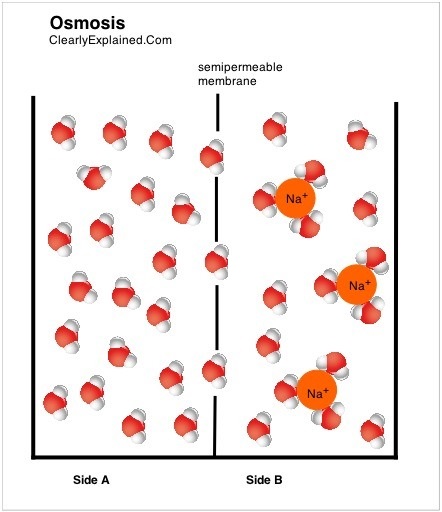Water Molecule Chapter 8 Quiz Questions

- 1.
Explain facilitated diffusion in terms of a.) how carrier proteins move particles through the plasma membrane(is energy required?), and b.)what type of particles are moved using facilitated diffusion:
- 2.
Briefly explain one type of cell membrane pump, and how it is able to move particles against(up) the concentration gradient.
- 3.
Beginning with G1: put the following stages of the cell cycle in the proper order: Telophase, Anaphase, G1(Growth Phase 1), Metaphase, S(Synthesis), Prophase, Cytokinesis, G2(Growth Phase 2)
- 4.
A.)Explain, in terms of the cell cycle, what causes cancer. Then, b.)list some possible causes of cancer and c.)some measures a person can take to prevent getting cancer
- 5.
In diffusion, particles move from an area of ______________ concentration to an area of ________________ concentration.
Explanation
In diffusion, particles naturally move from an area of higher concentration to an area of lower concentration. This is because particles tend to spread out and become evenly distributed. Therefore, the correct answer is "higher lower".Rate this question:
- 6.
How many FREE water molecules exist on side A (do not count the 3 water molecules currently crossing the membrane)?
Explanation
Every water molecule on side A of the membrane is a free(unbound) water molecule.Rate this question:
- 7.
How many FREE water molecules exist on Side B of the semi-permeable membrane(do NOT count the 3 molecules currently crossing the membrane)?
Explanation
Only 7 of the 16 water molecules on side B are FREE/not bound to sodium ions.Rate this question:
- 8.
Osmosis: In which direction would water molecules move in the above illustration?
- A.
Side A --> Side B
- B.
Side B --> Side A
- C.
No movement of water molecules
- D.
Movement in both directions to maintain the current equilibrium
Correct Answer
A. Side A --> Side BExplanation
Water will diffuse from an area of higher concentration of FREE water molecules (Side A = 19) to an area of lesser concentration of FREE water molecules (Side B = 7).Rate this question:
-
- 9.
When put into distilled water, a red blood cell will:
- A.
Inflate until it pops
- B.
Stay the same
- C.
Shrink (Crenate)
- D.
Double in size and then stay that way
Correct Answer
A. Inflate until it popsExplanation
Distilled water is hypotonic, and therefore has a higher concentration of water than red blood cells. Therefore, water will diffuse into the red blood cells, causing them to expand. Because the concentration of water in distilled water is 100%, water will never cease to diffuse in, because the concentration will never be equal. Thus, water will continue diffusing in until the cell popsRate this question:
-
- 10.
When a plant is placed into a salt water (hypertonic) solution, what happens to its cells?
- A.
Water enters the cell and the cell membrane pushes against the cell wall creating turgor pressure
- B.
Water leaves the plant cell and the cell membranes pulls away from the cell walls
- C.
Water enters and leaves cell at the same rate
- D.
The plant cells turn purple
Correct Answer
B. Water leaves the plant cell and the cell membranes pulls away from the cell wallsExplanation
the greater dissolved salt content of a hypertonic environment pulls water out of the cell causing the membrane to shrivel, and the plant to subsequently shrivel.Rate this question:
-
- 11.
Movement of particles from an area of high concentration to an area of low concentration through a membrane is also known as:
- A.
Active transport
- B.
Cell membrane pump
- C.
Reverse osmosis
- D.
Simple diffusion
Correct Answer
D. Simple diffusionExplanation
Simple diffusion involves the movement of particles from an area of high concentration to an area of low concentration through a membrane.Rate this question:
-
- 12.
What type of membrane protein allows ions to move passively through the cell membrane?
- A.
Cell membrane pump
- B.
Ion channel
- C.
Carrier protein
- D.
Vesicle transport
Correct Answer
B. Ion channelExplanation
Ion channels allow and control the movement of ions with the concentration gradient(passively), since ions do not easily pass through the phospholipid bilayer of the cell membrane.Rate this question:
-
- 13.
Passive transport uses __________ to allow particles to move ___________ the concentration gradient (energy/no energy) (against/with)
Correct Answer
no energy, with
no energy withExplanation
Passive transport is a type of cellular transport that does not require the input of energy. It relies on the natural movement of particles from an area of higher concentration to an area of lower concentration, which is known as moving "with" the concentration gradient. Therefore, the correct answer is "no energy, with."Rate this question:
- 14.
Active transport uses __________ to make particles to move ___________ the concentration gradient (energy/no energy) (against/with)
Correct Answer
energy, against
energy against
energy/againstExplanation
Active transport uses energy to make particles move against the concentration gradient.Rate this question:
Quiz Review Timeline +
Our quizzes are rigorously reviewed, monitored and continuously updated by our expert board to maintain accuracy, relevance, and timeliness.
-
Current Version
-
Mar 21, 2023Quiz Edited by
ProProfs Editorial Team -
Mar 10, 2014Quiz Created by
Lukemoll1415
- Atomic Theory Quizzes
- Chemical Bonding Quizzes
- Chemical Compound Quizzes
- Chemical Element Quizzes
- Chemical Reaction Quizzes
- Chemistry Practice Quizzes
- Clinical Chemistry Quizzes
- Electrolysis Quizzes
- Functional Group Quizzes
- Gas Quizzes
- General Chemistry Quizzes
- IBSL Chemistry Quizzes
- Medicinal Chemistry Quizzes
- Periodic Table Quizzes
- Rate Of Reaction Quizzes
- Reaction Quizzes
- Soap Quizzes
- Solution And Mixture Quizzes
- State Of Matter Quizzes
- Stoichiometry Quizzes
 Back to top
Back to top


